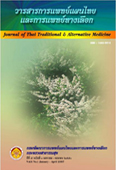Comparison of the Chemical Constituents in Michelia alba Flower Oil Extracted by Steam Distillation, Hexane Extraction and Enfleurage Method
Main Article Content
Abstract
White champaka (Michelia alba DC.) is a fragrant flower with a gentle scent that has long been utilized by Thai people; M. alba products remain widely popular in the Thai market. There are several methods for extracting aromatic oil from M. alba flowers and one of them is the enfleurage method which is believed to yield an aromatic oil with closely similar odor to fresh flowers. In this study, M. alba flower oil was extracted by a newly modified enfleurage method using developed buffalo fats along with other aromatic extraction methods; steam distillation and hexane extraction. The chemical composition of M. alba oil extracted from each technique was studied and compared using gas chromatography-mass spectrometry (GC-MS) data. According to the comparison study of M. alba flower oil, the enfleurage method gave a light yellow oil with similar odor to fresh M. alba flowers and its main composition was indole (1H) (35.5%), whereas the steam distillation method gave a colorless oil with similar odor to boiled M. alba flowers rather than fresh ones. Its major component was linalool (66.92%). The hexane extraction method gave a transparent oil sample with similar but more pungent odor to that of fresh M. alba flowers and its major compounds were 2-methyl butanoic acid and linolool (33.01% and 28.92%, respectively). Indole was also found as a minor component in M. alba flower oil extracted by the steam distillation technique, but was absent in oil extracted by hexane. With further comparison, linalool and 2-methyl butanoic acid were also found in oil extracted by the enfleurage method but in negligible amounts. With regard to perfumery, indole is the natural compound that increases
the perceived odor strength and improves the stability of other aromatic compounds in volatile oils. The major components of indole in M. alba flower oil extracted by the enfleurage method could be an obvious benefit of this method. In conclusion, M. alba flower oil extracted by the enfleurage method, using developed buffalo fats, has a desirable quality of aromatic oil, which should meet the high demands of the aromatherapy market.
Article Details
References
Herbarium, Royal Forest Department; 2001. p. 355.
2. Sinchaisri P. Aroma plants and essential oils. Nonthaburi: Neon book
media printing; 2004. p. 54-55.
3. Subcharoen P. Herbal and Thai culture: Part III, Aromatic plants.
Bangkok: The Institute of Thai Traditional Medicine Printing; 1999. p.
50-51.
4. Bunyapraphatsara N, editor. HerbsÇPlant folklore. Bangkok: Medicinal
Plant Information Center, Mahidol University; 1996. p. 712.
5. Valerie A W. The complete book of essentials oils and aromatherapy.
Novato (CA): New World Library; 1991. p. 15-18.
6. Oyen LPA, editor. Plant resources in South East Asia: 19 essential oil
plants. Thailand Institute of Scientific and Technological Research.
Nonthaburi: Sahamit Printing; 2002. p. 24-25.
7. Prabhasanobol D, editor. Thai essential oil (Part I). Thailand Institute
of Scientific and Technological Research. Bangkok: Seven Printing
Group Ltd; 2005. p. 16-21, 51.
8. Thailand Institute of Scientific and Technological Research. Extraction
of essential oil from flowers by cold enfleurage. Natural Agriculture.
2006; 2: 23.
9. Guenther E. The essential oil, Vol. 1. Lancaster (PA): Lancaster Press
Inc.; 1965. p. 13-14.
10. Shang C, Hu Y, Deng C, Hu K. Rapid determination of volatile
constituents of Michelia alba flowers by chromatography-mass
spectrometry with solid-phase microextraction. J Chromatography A
2002;942:283-8.
11. Joule J A., Mills K. Heterocyclic chemistry. Oxford, UK: Blackwell
Science; 2000. p. 25.
12. Basketter DA, Wright ZM, Colson NR, Patlewicz GY, Smith Pease
CK. Investigation of the skin-sensitizing activity of linalool. Contact
Dermatitis 2002;47:161-4.
13. Lewinsohn E, Schalechet F, Wilkinson J. Enhanced levels of the
aroma and flavor compound S-linaollo by metabolic engineering of
the terpenoid. Plant Physiology 2001;127:1556-65.
14. Sundberg RJ. Indoles. San Diego: Academic Press; 1996. p. 212-5.


